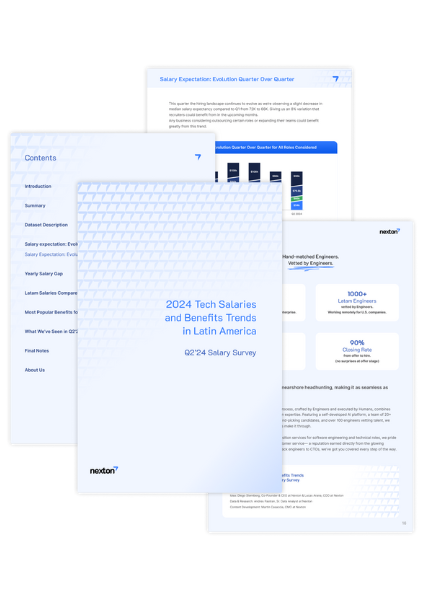Software engineers are often great at talking tech, but trip up when answering behavioral interview questions.
That’s normal. After all, behavioral interview questions are designed to put you under pressure and show potential employers how you handle stressful situations.
Luckily, you can ace behavioral interview questions for senior software engineers by leveraging the CARL framework. This methodology can help you answer questions with depth and detail –no matter what the interviewers throw at you! Keep in mind that you can use this framework for any type of interview, including technical assessments, such as live coding sessions.
Let’s explore what the CARL framework is and examples of how to use it effectively below.
What’s the CARL framework?
The CARL framework is an interviewing technique that breaks down your response into four key sections: Context, Action, Results, and Learning.
The idea is to use this model to give fuller, in-depth answers during interviews and impress potential employers by staying calm during tough questions.
Context
In the context stage, you’ll give the essential background info so that the interviewer can understand the situation. Some key questions to answer include:
- What was the situation like before I acted?
- Who were the key players?
- What was I hoping to accomplish?
Action
During the action section, you should outline what you did in response to the situation, as well as why you chose to act that way. Key questions to ask yourself may involve:
- What actions did I take and why?
- What actions could I have taken and why didn’t I?
- What tech stack did I use and why?
- What challenges did I face?
Results
Next, you’ll want to describe what happened as a result of your actions. This stage should answer:
- Did I accomplish what I set out to do?
- Were the results as I expected?
- What are the implications for similar future situations?
- How could I have improved the results?
- What value did I bring to the company and/or clients?
While you're describing your results, you should also share specific results expressed in numbers. For instance, you could say something along the lines of: “This project increased the company revenue by 12%”, or “Through this project, I increased the platform's subscription by 20%“. This helps the interviewer understand the results you're describing —and it helps you stand out!
Learnings
Finally, your answer should conclude with insights that you took away from this experience. Some guiding questions include:
- What did I learn from the experience?
- What did I do well?
- What would I do differently?

Example of using the CARL framework
To give you a clear idea about how to put the CARL framework into practice, let’s go through an example. We’ll use the common behavioral interview question “Tell me about a time you succeeded.”
Context
My team was spearheading the MVP prototyping for a new client who was looking to build an app to upload videos from their yoga studio. Our timeline was challenging, with only a week to get it ready.
Action
I was most concerned about our client’s business success, as there were a lot of yoga apps already on the market. To this end, I wanted our team to create something unique, so I led efforts to research what competitor yoga apps offered.
Results
During this process, I discovered that the initial concept of uploading yoga videos didn’t have unique value. Instead, I suggested that we fill a specific gap in the market: personalized recommendations for yoga sessions, including yoga playlists, yoga mantra combinations and yoga nutrition. This shift in vision added an extra week to our MVP timeline.
Learnings
Upon reflection, I’m proud that I did such deep research, as it informed the MVP process and gave our client greater value in their end product. That said, I had to extend the deadline for the prototype in order to incorporate these new insights. In a future project, I would try to more accurately gauge the timeline in order to better meet client expectations.
This is just one great example of how to use the CARL framework. If you’re interested in reading other examples, you can find even more common behavioral interview questions and answers here.

CARL vs. STAR
In addition to the CARL framework, you may have also heard of the STAR method. While both frameworks can be used to answer behavioral interview questions, they differ in a few key ways.
The STAR method stands for Situation, Task, Action, and Result. As you can see, some of these sections overlap with the CARL framework, while others are distinct.
The first main difference is that the STAR method has Situation and Task sections to give background information, while the CARL framework combines these two in the Context section. In this way, the STAR method focuses more time on explaining the background.
Secondly, the STAR method doesn’t include a Learnings section. This is significant, as often the most important stage is talking about takeaways and learnings from your experience. For this reason, CARL is a more powerful framework for sharing insights.
More tips for your next interview
While the CARL framework will help structure your answers, you can boost your interview skills even more with these tips.
1. Practice often and record yourself
Take the time to do mock interviews with friends or family, so you can practice aloud and get feedback from others. Practicing with people will also help you mimic the stress of the real interview. You can even record yourself and send the voice messages to friends, if you don’t have anybody nearby to help you out.
2. Consider cultural fit
Don’t forget that a big portion of the interview is about cultural fit. You should tailor your answers according to the specific role, company and perceived culture. When appropriate, you should also ask the interviewer questions to get insight into their processes and values.
3. Use your English wisely
Behavioral interview questions for senior software engineers can be even more challenging in your second language. If you’re feeling nervous about your English skills, prepare smartly. Don’t overcomplicate the interview with memorized phrases or monologues. However, it is a good idea to practice beforehand and have a few strong verbs on hand to use in your answers.
4. Don’t forget about non-verbal communication
Finally, your body language will tell the interviewer a lot about your personality and ability to handle stress. Try to stay calm and collected, with body language that’s open and comfortable. Maintain eye contact and avoid nervous gestures whenever possible.

Practice for your next job interview with Nexton
Now that you know about the CARL framework, you can start to incorporate this method into your interview answers. Keep in mind that this model provides a helpful structure, but that you can tweak it according to your needs.
Ultimately, job interviews can be difficult, but they’re a key step in landing your dream job! If you’re still looking for the perfect tech job, get in touch with us. At Nexton, we connect talented tech professionals in LATAM with amazing job opportunities in the U.S.
Check out more:
How to Create a Spot-On Elevator Pitch for Your Next Interview
9 Questions to Ask a Startup CEO or Founder During an Interview
Live Coding Interviews: Do’s and Don’ts
How to Prepare for a Job Interview in English


